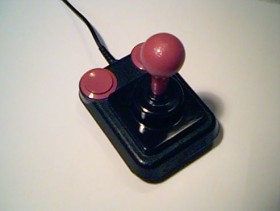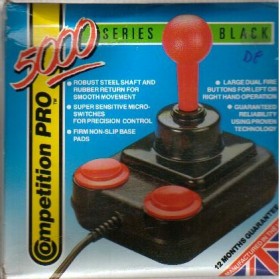That is a picture of the ‘Competition Pro’ joystick – the first (and I believe only) item I ever bought on lay-by.
Known as ‘layaway’ in the US, lay-by is the process of buying an item in installments. It is virtually unknown these days due to credit cards, but used to be very popular.
One day in 1984 (or early 1985), after endlessly reading about how great the Competition Pro joystick was in the imported UK game magazines of the day, I discovered they were sold at K-Mart, Charlestown Square. I remember seeing one in a glass case in the electronics section and wanting it so badly. In those days game systems did not come with controllers, so there was a vibrant market of third party devices. For me, the competition pro was at the top of the pile. The pinnacle of control! It even had microswitches!
This was the box:
I forget the price, but A$40 comes to mind. Whatever the cost, it was much more than I had available, and I was so worried about the joystick disappearing from the shop I hastily put it on lay-by. I remember being very excited as I collected the various documents (including payment slips) with all sorts of dates on them (“Pay this much by XX” etc.). I planned out my repayment schedule, based on what meagre income (pocket money?) I had in those days. I can even remember having dad drive me to the shop one day just so I could put $2 onto my lay-by! Only when the full price was paid would the joystick be mine.
Oh the unfettered enthusiasm of youth 🙂
Eventually I got my competition pro, and it was awesome. I still recall how much I loved the thing, and how much I loved the little clicks from the microswitches every time you moved the stick or pushed the button. It was the ticket to even higher love for my Commodore 64. I even carried it to friends houses when I went over to play games with them. I was so proud of it, and that I had lay-bought it.
Remembering this, and writing about it now, makes me wonder what ever happened to that beloved competition pro of mine. Is it in a box in an attic, dusty and forgotten? Or was it long-since buried in a mountain of landfill, or crushed in some reprocessing plant?
Or could it be – impossibly – that some retro enthusiast is loving it still, and using it to this day?


